How to Compost, The Wild Way
2/18/2023
our composting tips and tricks for kansas citiansWant to start composting but don't know where to begin? We were right there with you and have done the dirty work of figuring out the perfect, non smelly, no fuss way of composting. Here's our system! Have more tips or tricks? Add them in the comment section and we can all learn from each other. Check out our friends Compost Collective KC on their socials (@compostcollectivekc) for more composting information! Step One: Pickup a Compost Swap Bucket from USNext time you find the Camper at Brookside or the Warehouse, grab one of Compost Collective's Swap Buckets. $10 for first timers, $8 for swappers. It comes with a compostable liner, lid, bucket and instructions. Step Two: Perfect Your Home Composting SetupThere's a few tips we have for keeping the composting experience seamless and non smelly at home. 1) Place your bucket outside. This keeps the smells inside your house to a minimum while you're collecting your food scraps. A back or front porch near your kitchen door, a patio, etc. Don't have an outdoor space easily accessible? Line the bottom of your compost bucket with newspaper or cut up toilet paper rolls to keep the smells under control. I've also heard great things about activated charcoal liners like this one to reduce smells. 2) Find a little mini compost receptacle that works for your kitchen workflow. We use this because it can easily clip onto our kitchen cabinet to make sliding your food scraps into the mini compost bucket easier. Here are some suggestions: My Fave. Complete Package w/ Charcoal. Cute & functional. One Kim Kardashian would use. 3) Use little mini compost baggies to fit inside your mini compost can (usually 3 gallon works). Just be sure this bags are certified home compostable. A lot of greenwashing happens in this industry. Be wary of trash bags that are "green" but don't say certified compostable or BPI. Usually if it looks or feels like plastic, it's plastic and won't compost. I stick to World Centric, UNNI or BioBag. They can be found at Whole Foods, Nature's Own or Natural Grocers or Amazon. 4) Cook! Chop! Juice! Shred! Make delicious things! Whenever you have food scraps or compostable items (like our Wild Way cups, lids and straws), slide them into your mini compost receptacle until it gets full (usually 3-5 days). Once full, tie up your mini baggie and place into your lined Compost Collective Swap Bucket. Seal the lid tight. Bring your mini compost receptacle back in, give it a nice wash and let it dry before putting in a new liner. 5) Repeat! Keep using your little lined kitchen compost bin for your daily use, and whenever you fill it up, tie it and put in the lined Compost Collective Swap Bucket. It takes me and Jon about 2 weeks to fill up the big bucket! What is Compostable? How do I know? If you can eat it, it grew from the earth, or can return back to the Earth, it's probably compostable. Checkout our list of compostable items and then review Compost Collective's list of compostable items. Step Three: Bring Back Your Full Compost Collective Bin to a Bin Swap Location!The Wild Way is just one of MANY compost swap locations for Compost Collective KC. See their full list HERE. Visit us, or any one of these other locations to drop off your full bucket and swap for a new and clean one for only $8. No mess. No dumping. You just drop it and swap it for a fresh one. Easy peasy lemon squeezy (which are compostable ;)
Not to mention this is a great way to visit other Kansas City businesses you've never been to before! Exploring new spots while supporting small business AND contributing to less waste??? Could this be any more enticing?
Comments
The duck and the cardinal
5/19/2020
Written By: Christine CluttonIt’s 2pm on a Sunday and Jon has been tinkering with his new espresso equipment for two hours now. He’s building a new espresso cart and is finishing up the plumbing and small details today. He has methodically thought through every detail of this cart and has systematically, step-by-step built it over the past three weeks. He usually does so while blasting music over our Warehouse speaker system (that he also researched and installed himself), singing to himself every so often and sipping on single-origin espresso he tried some odd-experiment on that morning. Today, for example, he cut out a paper coffee filter in the shape of a portafilter, and lined it on the bottom of the basket before he dosed his coffee directly on top of it. He said it was “in theory supposed to increase my extraction yield,” but that “the results were underwhelming.” Jon's infamous "tongue's out" concentration face. Meanwhile I am sitting in the sunshine by the garage door window, tanning my white-winter-ridden legs and daydreaming about new ideas for the business, scribbling thoughts down into a journal I will most likely lose in the next week (probably in my backpack), and then rediscover in six months, to be reinspired by the words I write down today. I forgot to eat this morning, so I found some two month old Peanut Butter Granola that usually graces our food menu, but that has sat uneaten since the shut down. I ate five handfuls and washed it down with some cream top milk I picked up from our dairy farm this week. I’ll probably have another espresso here myself in a moment, which I will get my husband to make me...because it’s just better when he makes it for me. Then I’ll switch gears into boss-mode and update my website a little, put out the barista schedule, think of an insta post or two, place a few orders, and be ready for a glass of wine by 5. This is us in a nutshell. The methodical and systematic sweet-heart of a husband, and the day-dreaming creative slash business-minded bae (and yes, I just referred to myself as bae) who couldn’t be more different and yet somehow, it works. A few weeks ago a customer/friend (@kccoffeedates) asked me what it was like to work with my husband...and I told her I would one day write a blog about it. Here is that blog. Or at least, the start of it. There is so much I have to say about working with your partner. Today I’ll focus on ideologies and how that drives our passions and our business. On our last walk around our neighborhood, Jon and I were dreaming about the business and we both said we wanted “freedom” for our lives and our business. Now, what we both meant by freedom couldn’t have been any more different from each others’. Freedom for me is flying. Flying to new heights by dreaming of adventures and then taking off to soar to those new ideas, hoping the wind and pure flap of my wings will carry me there. I’m a red cardinal, ready to take flight. For Jon, freedom is not sinking. Not sinking by having knowledge of where he is going, how he is going to get there, and the data behind that decision. Freedom looks like the systematic flapping of little webbed feet, working really hard beneath the surface to discover all the points of data he can, and then having that data steer him into the next direction. Jon is a duck, ready to work his webbed feet. An example of this. One day after one particularly busy Farmers’ Market day, I wanted to see if we could afford to hire an additional barista to help us in the camper. I quickly did some math on my phone’s calculator and scribbled down a few notes onto a scrap receipt I had on my coffee table. Based on my estimations, we could afford another person. I asked Jon what he thought and he asked if he could “run the numbers”. Three hours later he had written code that compiled all our exact sales, exact COGS, exact labor, and fixed cost for that day. It showed up in a graph that accurately depicted our profit and our labor cost as a % of revenue. “We can afford to spend another 8% on labor if all else remains constant” Jon stated. So...we were both right….he was just MORE right. Or at least more accurate. We are a good balance that Jon and I, but that’s a balance we had to learn over the last four years of marriage, two of which were spent running this business. I have to tell him “just dream with me” when I don’t want him to ask me logistical questions about my one-off-ideas that I’m literally coming up with as I’m speaking. I just want him to let me dream with him. No restrictions, just freedom. He has to tell me “just let me do the research” before we make a big (or small) adjustment to the company. No making un calculated moves, no sinking, only freedom. photo cred: Stephanie Smith of @stephaniesmithKC We haven’t always been good at that balance. And we definitely have our days where we forget what the other needs to feel freedom. It’s a learned and practiced skill. One that takes long conversations, maybe the occasional fight or two (or three), and the humility of realizing you’re stronger together. But it’s a skill I’m proud to say we are continually working on, and affording ourselves a big helping of grace when we don’t get it quite right.
So, to answer my friend Tricia's question, “What’s it like working with your husband.” It’s an adventure. It’s a way to learn more about my husband and best friend. It’s an easy way to fall more in love with a duck. And a learning experience in exercising my wings. I hear Jon rolling his newly finished espresso cart to the front of the Warehouse, and I think it’s about time for my next shot of espresso. Okay, there’s not a super strong correlation between Ethiopia & Baby Yoda...EXCEPT a mysterious and hella relevant “origin” story. (This is funny on a lot of levels; see “single-origin” coffee). And if you don’t know who Baby Yoda is, welcome to the internet. Ethiopia is known as the birthplace of humanity and also the birthplace of coffee. Coincidence? I think not. But, let’s leave the humanoid/evolution/LUCY(remember her?!) conversation for family get-togethers and stick to coffee here. What do we mean when we say the birthplace of coffee? Basically, the coffee you drink is under a big umbrella called “Arabica”. You may have heard this before. It’s the species of coffee that’s most commonly grown and consumed. This species traces its beginnings to Eastern Africa, now Ethiopia. From here the Arabica species of coffee plant was taken and via Yemen, split into two main off-shoots (Typica & Burbon), and was planted all over the world giving us many different varietals, off shoots, and mutations. This pic should help! Credit to SCA! But HOW did we discover coffee you ask? In my opinion? Who knows. It’s like asking where did Yoda come from. We can only speculate. There is, however, a story we’ve collectively signed off on that I’ll tell you. Long, Long- Ago, in a field full, full of hay, was a goat-hearder named Kaldi and all his goats (maybe one named Yoda? Could be!). Kaldi was out and about doing his thing when one or more of his goats started acting wacky AF. Naturally, he was curious what these crazy kids (goat joke) had gotten ahold of. He figured out the berries on a nearby bush must have been the culprit and as any good goat-hearder would do, he ate some because, you know, why not? Now Kaldi is turnt. He went to the local market where his buddies are at and hooks them up with the first cup of coffee ever – and the rest is history. Now, it is super cool this commodity product so many people consume, have consumed over centuries, make careers from, and use to fuel the day has such a long history. It is also SUPER cool that Ethiopian coffees are SUPER popular for their interesting and dynamic characteristics. So we decided to create a panel of Ethiopian coffees, showcasing here at our Warehouse for the next few weeks both on pour over and on espresso so you can get your #KaldiKraze on! Here's a preview of what we're offering! The four Ethiopian coffees we've curated to share with y'all:
- A natural process Kayon Mountain from Lexington Coffee Roasters out of Lexington, VA, with a score of 94/100 from Coffee Review : look for notes of dark chocolate, melon, and pineapple. - A natural process Yirgacheffe from Dragonfly Coffee Roasters out of Boulder, CO, rated as the roaster of the YEAR by Roast magazine (slow clap) : look for notes of berries, candied lemon, and clove. - A natural process Limu from Empire Espresso in my old neighborhood of Columbia City in Seattle, WA : look for notes of sugarcane, bergamot, and mango. - A washed process Worka that was bought by Atlas Coffee Importers (primo importer X 100 billion) partnering with roaster& friends; Cat & Cloud from Santa Cruiz, CA : look for notes of jasmine, peach, and Meyer lemon. Please join us THIS Saturday, 1/25/20 for a special experiential event as we unveil these coffees! All day we will be pulling shots of these four coffees, and slinging some pour overs. Come between 9AM-10AM to experience these coffees side-by-side with a flight of all four on Kalita Wave brewed by coffee master, Christopher Melton. $7 for a flight of all four. Get REAL caffeinated by taking shots of each espresso as well. Why not? Let's taste some of the best coffees out there! For more info on the event, click here! Can't make it Saturday? No fear, these coffees will be around for the next month. Try one, try them all and discover the true origin story of coffee, Episode: Ethiopia. 22,308,000,000 pounds of coffee are produced yearly around the world. 1 coffee tree is needed to produce 1 pound of coffee per year. So, let’s talk (coffee) plants. Is it a tree? Is it a bush? Only God knows (technically it’s a shrub but tree is fine ‘cause they’re tall). ....Moving on. Coffee trees can be grown to a multitude of sizes based on how they’re trimmed and pruned – this is typically done to maximize hand picking. The tree grow little berries called “cherries.” These cherries start as green and as they ripen, turn red (hence the name cherries) alerting the farmer it’s picking time! These cherries are what we all covet. All of us feverish caffeine-cravers, the ever alert java-junkies, the latte-lappers, and so on. Inside a coffee cherry is a number of components, which you can see, such as silver skin & mucilage, etc. These components are valuable, but for us, our focus is on the seed(s). You can see there are two seeds inside the center of the fruit, each with a flat side that faces inward and a rounded side that faces out. If you buy your coffee whole bean rather that pre-ground (which you should #justsayin) you have probably seen this before. The seeds, most often called beans, grow annually on the coffee tree – occasionally bi-annually – but the second yield is considerably less desirable, as the tree has given its best effort and nutrients to the first crop. We should take a moment's pause to appreciate as consumers how the coffee is only ripe and pickable once a year. This means a great deal for the farmer, soil, coffee sourcing, etc. We will revisit some of these topics in later posts, so stay tuned. FUN FACT #1 – On occasion, a cherry only produces a single, rounded seed, called a “peaberry”. These are interesting because they’re rare and have to be treated differently during processing and roasting. For example, each peaberry is sorted and set aside by hand! Coffee grows almost exclusively in what is known as the “Coffee Belt”. This belt is an area near the equator, below the Tropic of Cancer, and above the Tropic of Capricorn. (Thanks Ms. Frangella, 6th grade geography teacher #latitude-fatitude). This section of the globe has steamy enough temperatures needed to grow a tropical plant like coffee – this is why some coffees have tasting notes described as tropical fruits or cocoa. These areas are opposite to that of wine regions. God decided it was best to separate the two best crops so not to show favoritism. Please enjoy this never-before-seen picture of Jesus enjoying his morning coffee. In addition to temperatures, we need other conditions to produce healthy coffee trees and cherries, such as elevation. Why? Because the higher a plant grows, the more it struggles (for example: rockier soil and less oxygen), the more it struggles, the denser the fruit. The denser the fruit, the more concentrated the flavor and more resilient the bean is to the heat of roasting. Less dense beans are simply more frail and can’t withstand the roasting process. So let’s recap: The steamier the temps and the higher the elevation, the more the bean struggles and therefore creates a denser, more concentrated, more resilient bean which is better for roasting and in turn best for drinking. Maybe there’s a life lesson in there? The harder the struggle, the better the brew. Maybe that will catch on. FUN FACT #2 – a lot of coffee grows on or near volcanoes. Good rich soil and great elevation. Generally, the coffee belt is split into three main growing regions: Asia, Africa, and Latin America. You can see on a globe that these are the masses of land found in near the equator. These regions are typically understood for having their own general flavor profiles that are most commonly expressed in a coffee crop produced in that area. Latin America is known to be chocolatey and nutty. African coffees have elements of berries and citrus fruits. And Asian coffees are earthy and softly spiced. These flavors are again, natural tasting notes that come from the tree (not from additives). I hate to be the bearer of bad news; but if your coffee tastes like a peppermint patty hit you on the face, that’s not natural. If your coffee tastes subtly of fresh blueberries or candied walnuts, that’s all nat-ur-al. The tree’s specific varietal and the growing region also imparts their natural flavors. This flavor imparted by geography alone is called “terroir” and if you think, “Hey that’s pretty beautiful that the earth just gives up complex, rich, and dynamic flavors all on its own” ... you’re right. Coffee plants, the elevation, the terroir, all contribute to RICH flavors that are unique to that particular plant, in that particular location. Which leads us to our main point. What do coffee plants and Lizzo have in common? Both are 100% that rich. Until next time, when we will delve into that rich terroir more.
Kenya Believe it?!
12/11/2019
We are very happy to announce something that we’ve been working on behind the scenes at The Wild Way -- a special collaboration with Repetition Coffee from Lawrence, KS!! (Shout out LFK.) Repetition Coffee has a special place in our hearts. We carry their coffees and showcase them on our pour-over menu because they’re damn good. In addition, their head roaster and owner, Amy Pope, is 10/10 a badass & essentially a local hero. Did she save a cat from a tree? Maybe! Did she create a meaningful company that literally screams “local” while honoring a global product? Yes. Hell yes. We partnered with Amy to bring you Bora Pamoja; a coffee that’s as rad as the lady who roasted it and the country it came from. So I want to show you all two things; 1.) Amy’s perspective on sourcing & choosing this coffee, and 2.) The Wild Way process of building a professional recipe for different brewing methods! Let's get to it!! “ I fell in love with and tasted this coffee for the first time in February when I was on a sourcing trip to Uganda and Kenya with Crop to Cup. C2C is a small coffee importing company based out of NYC. It’s founders previously worked for the UN on water works projects in Uganda, so their relationships are deep. They speak Swahili and Buganda, understand the local culture, and the Eastern African coffee market, which made them the perfect tour guides through both countries.” - Amy Pope, Repetition Owner SOURCING COFFEE: When traveling to other countries, dealing with other markets, and most importantly other cultures, having a knowledgeable and a locally sensitive partner is irreplaceable. “The main challenge in Kenya is to find coffee estates that are locally owned and/or locally run…The Kiriga Estate is Kenyan owned, purchased from British settlers with coffee plants 50-70 years old. The estate is located in Murang’a in Kiambu, just north of Nairobi. Because of the very rigorous, quality-driven auction system, the coffees that come out of Kenya are some of the highest quality coffees in the world.”-Pope OWNERSHIP & AUCTION: Kenyan owned farms ensure the most of the finance stays in Kenyan communities. If you want your coffee bought at a coffee auction in Kenya, the quality has to be absolutely premier. This Kenya coffee is SL-28 and SL-34 varieties and because Kenya coffees naturally have a higher acidity, a light, shorter roast on this bean is able to preserve the natural acidity." - Pope VARIETALS & ROASTING: Wondering WTF is a “SL” and why do I care? Scott Laboratory varietals (‘SL’ for short) are, well, the absolute shi*. Hired by the Kenyan government long-long-ago Scott Labs identified the most agriculturally and economically viable coffee varieties and now we have the top 2 (SL-28 & SL-34). SL-34 is typically rockin’ the mouth feel department, creating a syrupy & lingering cup! SL-28 (my favorite varietal of all time so I’ll try to slow down and breath right quick) is the higher altitude, sparkly, complex, sassy cousin of SL-34. Mash ‘em up and you’ve got yourself a dynamic and taste tour of Kenya! Keeping these flavors intact means choosing the right roast profile, so that’s why Amy and her team chose a lighter roast. P.S.) Okay, I’m gonna do a whole post on Scott Laboratories, SL-28, and varietals so if you’re still feeling like I might as well be talking about Dexter’s Laboratory instead of Scott Laboratory...we got you covered in future posts! Now, onto our own process at The Wild Way! We’ve seen that there’s A LOT of work that goes into the coffee before it reaches a coffee shop. A great team of baristas will always do their best to honor the roaster, the farmer, and the crop by preparing the coffee in a way that highlights each stage of the coffee’s journey and the intent for the bean as it goes along. Our job is the final step before it gets to you, the customer! For us, this means tasting the coffee over and over, tweaking and dialing in along the wild way. A “drip” cup of coffee can have different ratios of ground coffee and water. It can have a thicker or thinner gauge of filter that holds back more solids in the cup. There can be paper filters, metal filters, cones & flat bottoms. And that is just the start. And, #TBH, we also go through a detailed and finicky process for espresso as well. As we went through the recipe journey, we settled on what we like best; for pour-over we stick with our tried and true 1:15 ratio and use the flat bottomed kalita wave as our brewing device. This slows down the extraction and boosts the mouth feel of the SL-34, helping to add some sweetness and balance to the lively acidity of all Kenya coffees. In the final cup we taste some bougie flavors like dark caramel, candied orange, and sweet rosemary. For espresso, we took a typical 1:2 ratio, nailed it. Bright lemon-meringue flavors pop out with a subtle finish of sugary sweetness. We also thought we might push the limits a little. So we played with, and loved, a 1:3 ratio as well. Fellow baristas feel free to close your gaping mouths. Mischievous and magnificent results. This ratio gave us round flavors...dark bootstrap molasses with caramelized grapefruit acidity. Y’all...this coffee is life. We named the coffee, Bora Pamoja, which means "better together" in Kiswahili. We chose the name to honor the relationship between the farm, importer, roaster, and brewer. We are all, better together. A big thanks to Amy and the Repetition team, Crop to Cup Importers, and of course, The Kiriga Estate in roasting, sourcing, and producing this coffee. We are honored to have our name on this bag and brew this coffee in our camper! Come be one of the firsts to taste this collaboration coffee at our Warehouse Sunday the 22nd (rescheduled from the 15th due to snow storm!) where we are throwing a party in its honor. The collab bags are for sale (Christmas anyone?) and is being served in three different ways in the camper! Swing by the Warehouse 10am-2pm on the 22nd to be a part of this coffee’s story! #SQUAD
11/18/2019
#WILDWAY #SQUADThere are several things that are worth celebrating with a blog post. Your dog learned how to sit on command, for example. You decided to go vegan, raw, paleo, gluten-free, dairy-free, and/or diet-free. You found a new lipstick shade you really like. You know...all the major highlights we have in this life. So, although I’m not sure I can top the most recent viral blog post put out into the internet world, I sure as hell have something worth celebrating (and blogging about). And that my dears, is my bad ass team. Or as I like to call them, the #SQUAD. Megan - Camper CREW LEADSweet Megan, woman of many talents and wearer of many hats! (Literally, she has lots of good hats). I was lucky enough to hire her back in April before I knew exactly what I’d be getting her into. This girl has been through it all with us the past few months and has kept me sane and smiling the whole time. Meg’s got it all. She has grit. She has stamina. She has the smarts. Ask her to hitch up a trailer and she can do so in 2.5 seconds. Ask her to lift five gallon water jugs over her head and watch her flex. Ask her to pull you the best shot of espresso in your life while carrying an in-depth conversation and be amazed. I’m one #proud bosslady over here because of this one. WHITNEY - CAMPER CREWWhitney floated into my life right when I needed her. I was in desperate need of someone who could stand in front of a line for hours on end, taking drink orders, hustlin’ granola bowls, and pouring out drinks without skipping a beat. If “Marathon Register-er” was a thing, she’d win the freaking gold. Her natural 7 enneagram keeps us all grinning and goofin’ throughout those busy days and we are a stronger team because of it! Jon and myself - trailer driversAnd then there is us. Y’all probably know us PRETTY well by now. So here are a few facts about The Cluttons that you pry don’t know. 1) Jon is my personal chef and literally I forget to eat if he doesn’t feed me. I blame it on being busy but in actuality, if you’ve had his food - you’d know why I don’t eat anything else. Bonus fact: Yes, he does cook with his tongue out constantly. 2) I definitely stood Jon up the first time he asked to hang out with me (at a coffee shop...naturally). We didn’t see each other for nine months after that because I studied abroad in Italy that next semester and then went straight to Kenya for the summer. (Also, why does my life as a college student sound so cool?) Womp Womp Womp..... 3) Years later, while I was dating Jon, I went back to Italy with a dear friend and while I was there, Jon made a 24 hour driving trip to Kansas and back to ask my parents for my hand in marriage. When he picked me up from the airport the next day he was wearing a suit and had flowers in hand and I DEFINITELY thought he was going to propose right then and there...he did not and I had PTSD for the next month. Anytime we went on a date I would start getting nervous that he’d pop the question. Finally, on HIS birthday-date (that he planned...not sure how that worked out) I was so nervous I just looked at him and said “If you’re going to propose you might as well do it now.” And he did. :D Bet y’all didn’t know those stories, did yah?!? when can i meet this new #SQUADI know y'all are all thinking it. WHEN CAN I MEET THESE HUMANS THEY SOUND AWESOME!?! Well for the next three weeks, Jon and I are going rogue and heading to Italy (finally making it up to him for standing him up on that first date) and leaving our crew in charge of Warehouse days which are happening every Wednesday AND Saturday now! 8am - 2pm each Wed & Sat you can find them serving up spro and good vibes at our little converted warehouse space in the East Crossroads. Go say hi, hand out a high-five, give them some encouragement, tell them how good their drinks are, etc etc. They are looking forward to serving you. And I am looking forward to a few dates in my favorite country. Ciao Kansas City. A doppo. WILD Water
1/12/2019
Welcome to 2019! Wow. What a year 2018 was. For our first year in business, it was pretty WILD. We definitely named our business appropriately. I wonder if we had named it "The Calm Way" things would have been a bit more....tame. Guess we'll never know. Luckily we wouldn't change our name, or the road we're on, for anything. We met so many awesome people over the last year. 2018 was one for the books. Now, as we start 2019, I wanted to write about the same thing I wrote about in 2018 - water. Water! (The stuff that jon is obsessed with)In case you want to revisit the posts about water in 2018, I've provided links below. Top two are definitely An Ion Took a Compound on a Date and #MakeScienceCoolAgain. I got a little nerdy in Into to Total Hardness, so it's probably okay to skip. And we left off with us trying to figure out the water recipe in Dialing in Water? Is That a Thing? It's probably okay to skip too. Abbreviated version, I screwed up the experiment. So that left us with a few months to figure out the water recipe. I tried a bunch of coffee, and over the course of those couple months, we figured it out. I swear that I have tried so much drip, so many pour-overs, and so many shots of espresso with so many different water combinations that we decided to plan a whole event around water. As if, our obsession wasn't weird enough.... So that's what we're going to do! A water tasting party! We'll all sit around drinking the same coffee with different water and discuss what makes the difference from cup-to-cup. You'll learn things about water, and coffee, you didn't know you even wanted to know! But for real, we're proud of this, and we're excited to share it with you. Drip coffee is 98% water (we did the math this time :) and when it comes to body, sweetness, and flavor, that water is the most important brewing factor. Here's the link for the event details. It's a free event, but we need you to sign up because there are limited seats. Water for coffeeIn case you feel like making your own water for coffee, I wanted to detail out the process we took to develop ours. It took me summoning all of little Freshman Jon's chemistry knowledge. Mostly acid/base equilibria, but a little bit of thermodynamics as well. If you don't feel like making your own water for coffee, Christine and I are going to sell some in the shop. You're always welcome to stop by and grab some. How to do this at homeThere are a few different way to do this. The first, somewhat more challenging way, is to learn everything that you can. Like...EVERYTHING. Christine calls this, "the Jon way". Reading things from the experts is the best way to start this process. There are a bunch of good resources online. Start here. It's a talk by Maxwell Colonna-Dashwood. It gives the story behind the science. Then, I'd suggest reading all our crazy blogs from last year about water. (Yes, even the ones I said weren't important to read above). THEN, move onto these: Dissolved Minerals in Water and Their Effect on Coffee The Science of Finding the Perfect Water for Coffee And finally, when you think you've read enough about water....read this book, Water for Coffee, written by the expert Dr. Christopher Hendon. It sits atop our little bookshelf in the trailer. You're always welcome to come stop by and read it. You can also see the paper behind the book published in the Journal of Agricultural and Food Chemistry,- Hendon et al., 2014. Now, the second method, is the "Christine Method". It is much more efficient. Like....much, much more efficient. Here it is: grab some epsom salt, baking soda, and a white lab coat (that's just for show) and try out these recipes. Make some coffee with it. You're done. You're an expert. Christine Method Resources: Barista Hustle Water Recipe DIY Water Recipes: The World in Two Bottles White lab coat Whichever method you choose, just enjoy it. Enjoy the process. Try. Fail. Try again. Fail again. Drink a beer. Try again. And if you need help, you know where to find us. See you on the 19th!Here is the link again for the Water Cupping. We will go through our process, taste some coffees, learn about water, and answer any questions you may have.
If you can't make it to the event, we will start selling our "Wild Water" in mason jars at the shop. So you can brew coffee at home with our special water. Kansas City, thank you so much for letting us serve you in 2018. It has been amazing. And to my sweet wife - Christine thank you for allowing me to turn a coffee shop into a chemistry lab. Thank you for empowering my passions and dreams and finding ways for them to grow symbiotically with yours. Thank you for letting me obsess, just a little bit, about water. And thank you for being you. The Beauty of Being Small
12/10/2018
by Jon CluttonFor the past eight months, it's been me, Christine, and our camper. We wanted to take the road less traveled. To make coffee the way we wanted to make coffee. Greet people the way we wanted to greet people. And serve the ingredients we wanted to serve. No shortcuts. No worries about maximizing profit margins. Just the biggest smiles and the best coffee possible. Because we've been so small, we've been able to focus on things that ordinarily would be put on the back burner and written off as "good enough for now." We have spent countless hours on manipulating water recipes (yes...water). Steaming all kinds of alternative milks. Driving hours to and from De Soto to get farm-fresh milk from a local Kansas dairy. And pulling countless shots with different pressure profiles. We are able to do these things because, we are small. And we like it that way. The Beauty of being smallDark horse. Drip coffee is 98% water.
The beauty of being small is that we get to pay attention to that 98%. I swear, I have tried so many different shots of espresso with so many different combinations of water. The number one mediator of spro (espresso) quality is water. Same with pour overs. Same with drip. Same with all coffees. The beauty of being small is that all of our water has to be brought into our little camper and stored in tanks. We can put whatever water in those tanks that we want. And instead of bringing in city water and running it through filters, we dose our own water with a recipe of minerals that best suits our espresso, our equipment, and our desired taste profile. On any given Sunday you may see Christine and I at Natural Grocers, filling up 40 gallons of water from their Reverse Osmosis system. We can do this, because we are small. A 12 oz. latte is 80% milk. The beauty of being small is that we get to pay attention to that 80%. I fell in love with coffee over iced lattes. In the hot Austin heat, there's nothing better. The thing that made these iced lattes was Mill-King milk. It's low-temp pasteurized, non-homogenized, and 80% of my iced latte. The beauty of being small is that we get to use small, local dairy. And not any small local, dairy, but a small local dairy that treated their cows humanely and offered non-homogenized milk. Hildebrand is the only one. It makes our iced lattes what they are. If you're interested in more information about the importance of milk, see here. Coffee is 50% growing, 50% roasting, and 50% brewing. (Yes, we know that math doesn't add up). The beauty of being small is we get to focus on brewing and let local roasters focus on roasting. These two things (brewing and roasting) are very different beasts, and Christine and I would not be capable of taking on both. We get to partner with Repetition, Oddly Correct, and Blueprint Coffee. All of them are incredible, local roasters doing incredibly high-level work. I just want to take a second to talk about Repetition. We use their single-origin Mexican on espresso and drip coffee, and lately we've really been digging their Kenyan and Ethiopian on pour-over. Repetition is run by Amy and Ryan Pope out of Lawrence, Kansas. I feel like their own words describe them best. "Here, we apply an ethos of sustainability and respect, global connections with growers, and refined yet adventurous palates to the work of making every single cup memorable." The thing that makes me proudest to partner with them is their focus on gender-equality in coffee, all the way from farm to cafe. It's a topic that hits home. Amy recently traveled to the Cauca department of Colombia where she visited with the Asociacion de Mujeres Productoras Agropecuarias del Cauca (AMACA), an association of women coffee producers. Established in 1999, they now have 208 members and advocate for women's ownership over land and resources, and leadership within their respective communities. So let us recap. Amy, a bad ass female head roaster and business owner, traveled to Colombia, to meet some bad ass female producers, where she ordered their bad ass green coffee, that was roasted, and is now being sold at my wife's bad ass coffee shop. Need we talk more about how insanely cool this is? Who runs the world? Girls. That's who. And lastly. But certainly not least. A coffee shop is 100% about the customers. The beauty of being small is we get to focus on that 100%. If you haven't been in the cafe, then let me paint a picture. A smiling human behind a baby blue espresso machine, who knows, that you are just as much a part of the wild way as they are. Without you guys, we wouldn't be here. We say this often, but this broken record won't stop repeating. You guys, are what make this possible. You guys are what make being small, so fun. GOT (CREAMTOP) MILK?
6/12/2018
by Jon CluttonAt The Wild Way, we like to take the road less traveled. And sometimes, we mean that quite literally. That's why we drive out to De Soto every Wednesday to pick up our creamtop milk order from this awesome small dairy company out of Junction City, Kansas - Hildebrand Farms. We think their milk is THAT good and throughout the blog I'll get into the science of why. They don't deliver to Kansas City, so we meet them the furthest East they come, De Soto. They are literally the best. Milk For Coffee There are three main components in milk: sugar, protein, and fat. Lactose, is the main type of sugar in milk. It's about 15% as sweet as table sugar. It adds that subtle sweetness to your lattes. You definitely want a high lactose content in your milk. Hildebrand comes in on the high end with about 12g. The majority of protein in milk is casein. Casein groups together in bunches called micelles (remember this for later). You need protein for good lattes. Protein allows for the stabilization of microfoam. Without enough protein, you get very watery lattes and some shady looking latte art. Both the amount of fat and the size of fat globules in milk have an impact on mouthfeel (Chojnicka-Paszun et al., 2011). You don't want too much or too little fat. Too little (fat free) and you lose the creaminess and texture on your tongue. Too much of it (heavy cream) and it blocks receptors on your tongue and consequently your ability to taste the coffee. Similarly, when suspended fat globules are too small, you lose the velvety-rest-on-your-tongue deliciousness. When fat globules are too big, the milk starts to taste heavy. Busting the myth that fat is unhealthyThis is a touchy subject for a lot of people, so I'm going to be careful with it. Because of my autoimmune disease, I dove pretty hard into the nutrition literature this last year, and it's made a big difference for me. I learned so much. At the same time, I understand why health and the fat topic can be a sensitive one, so I will try to approach it carefully and stick to the literature and people much smarter than me. I've included articles by some people that I really trust. What they discuss and what most of the evidence points towards is that we were misled by much of the low-fat advice we were given in the 1990s. Fat is an important and necessary contributor to the diet, especially high-quality fat sources like olive oil, avocado oil, coconut oil, and grass-fed animal fat sources. Fat is important for the absorption of fat-soluble vitamins like vitamins A, D E, and K, many of which Americans are deficient in. I won't dive into things more than that because I'm not a medical professional and more importantly, I don't want to be another lecturing blogger. But, there are some really smart people out there who are working hard on preventing chronic disease through lifestyle change. I've linked their work below. I would strongly suggest reading their stuff, looking at the data, and coming to your own conclusions. When it comes to health, there's a lot there to learn. If you ever just want to have a casual conversation about this stuff, come stop by the trailer on a Saturday. I do research for KU med and one of my passions is empowering people to read, understand, and be confident in research. Books Paleo Principles by Sarah Ballantyne The Case Against Sugar by Gary Taubes. The Big Fat Suprise by Nina Teicholz Blogs What About Fat? - Sarah Ballantyne The Diet-Heart Myth - Chris Kresser Saturated Fat Does a Body Good - Chris Masterjohn Homogenized Somewhere down the road we decided we don't like things to separate. Peanut butter - throw some hydrogen in there (I see you Jiff). Almond milk - let's put some emulsifiers in there. Milk - let's homogenize you. Naturally, fats (hydrophobic elements) and water/sugar (hydrophillic elements) don't like to mix. We all know this. We've seen real peanut butter separate. Without homogenization, milk does the same thing. As you let milk sit, a layer of cream rises to the top (hence creamtop). This layer of cream is what's used to eventually make butter. This layer of cream sits on top of our milk bottles. If you visit us at the trailer, this is why you may see us whisk the top of a new milk bottle or ferociously shake a milk jug before pouring from it. This is the natural way to incorporate the cream and milk. Sometimes, you are lucky and you even get little bits of fresh cream in your iced lattes. Those bits are the best part, so enjoy. Now onto more science. Let's look at milk from a more molecular level. When milk is least processed it has large globules of fat and micelles of casein protein suspended in it. In the image below, you can see the globules of fat. And in the image below that you can see a casein micelle. Casein Micelle The homogenization process breaks down the globules of fat and the micelles of casein to mix everything evenly so that there is no separation between cream and milk. To do this, dairy manufacturers push milk through really small pores at high pressure. This breaks the fat globules and casein micelles down until they have a significantly smaller diameter (Sandra et al., 2004). You can see the impact of homogenization in the image below. Where did all of the tasty fat globules go? Homogenization causes issues for a couple reasons. 1) Taste Issue. In Christine and I's opinion, non-homogenized milk tastes better. It tastes creamier with a better mouthfeel and a velvety texture. The size of the fat globule impacts the mouthfeel of the milk, and as the fat globules shrink in size, you lose some of the texture of the milk (Chojnicka-Paszun et al., 2011). We think that non-homogenized milk tastes more natural, more creamy, and velvetier. Definitely worth trying, if you're up for a little adventure. 2) From a health standpoint, homogenization causes issues for some people. Milk is the second most allergenic food in children (Williams, 2013) and casein has been shown to cause gluten cross-reactivity (Vojdani et al 2013 and Paleo Mom article). Both of these issues are related to leaky gut syndrome. The issue with homogenization is the impact that it has on the casein micelles. Casein is meant to be delivered slowly to the intestine for easy digestion (Argov et al., 2008). However, after homogenization the size of the casein micelles are significantly smaller (Sandra et al., 2004)., effectively exposing more casein protein to the gut more quickly. For those of us with gut-related issues or sensitivities, this can increase inflammation and leaky gut. For some people, this is why milk sits so poorly. Often times it isn't the lactose, but a food sensitivity caused by the increased casein exposure to the gut from homogenization. When Christine was at Cuvee, this is when we first learned about non-homogenized milk. She used a local dairy, Mill-King, from Waco, Texas area at the coffee bar. Mill-King also did not homogenize, and because of that, several of Christine's customers came to Cuvee to get lattes because they considered themselves milk-intolerant to anything other than Mill-King's milk. Milk homogenization has become so mainstream that almost all major dairies homogenization their milk, and even small-scale dairies do as well. That is why it was impossible for Christine to find a dairy that delivered to Kansas City that we could order our milk from weekly. Hence the road less traveled and a 45 minute drive out to De Soto each week. Grass-Fed vs Grain-fedThe data are clear when it comes to grass-fed vs. grain-fed beef - grass-fed are healthier and more nutrient dense (Daley et al., 2010). Grass-fed beef has higher levels of the hard-to-obtain, active form of vitamin A, higher levels of powerful antioxidants and nutrients glutathione and CLA, and a better ratio of omega-3 to omega-6 fatty acids, not to mention a number of other benefits (Daley et al., 2010). Unfortunately there hasn't been nearly as much research done on grass-fed vs. grain-fed milk; however, according to the data that we do have, the nutrient comparisons are very similar. Grass-fed milk is 2-5x higher in CLA, a nutrient linked to a decreased risk for inflammation, cancer, obesity, cardiovascular disease, and diabetes (Dhiman et al., 1999). Grass-fed milk has about a 2-3:1 ratio of omega-6 to omega-3 fatty acids, compared to an 8-40:1 ratio of grain-fed milk (Patel et al., 2013). Omega-3 fatty acids are generally anti-inflammatory, while omega-6 fatty acids are pro-inflammatory. An ancestral ratio is about 2:1 omega-6 to omega-3. The higher the ratio, the more the body is pushed towards inflammation; one reason why our current commercial food process of grain-fed beef causes such issues.. Lastly, we know that grass-fed milk is higher in monounsaturated fats like oleic acid (found in olive oil) and medium-chain tryglycerides (found in coconut oil), giving a more balanced fatty-acid profile compared to grain-fed milk. HildebrandIf you're still reading this, wow. Props to you. You are a champion. You are a reading warrior. I cannot believe I wrote this much about milk. So, all of that information I just threw at you brings us back to Hildebrand. Why did we choose to take the road less traveled? 1) Hildebrand is awesome. They are local, small dairy with incredible employees. 2) Hildebrand is the only local, small-dairy to offer non-homogenized milk. 3) Hildebrand pastures cows year-round and supplements with alfalfa hay, silage, rolled corn, and soy when necessary, with the rolled corn and soy making up about 5% of the ration. These grass-fed efforts lead to ideal nutrition. 4) Hildebrand tastes the best, especially with coffee. :) Come try it for yourself. By Jon CluttonDear our amazingly generous, gracious, adventure-seeking 150 first customers.... photo cred: Adri Guyer We can't thank you enough for coming out to support The Wild Way Coffee on our first week of business. Especially since, somedays, we were operating in less-than-ideal situations. Let me explain... No matter how much you prepare, sometimes your generator goes down right before your Media Day starts. Sometimes, your coffee brewer is at a slight tilt because your operating a coffee shop on wheels and it makes the coffee taste watery. Sometimes, you think you fix your water issue by flushing gallons of Reverse Osmosis water into your machines and it comes back the next day unannounced and you don't know how many people you served that coffee too. Yes, all of those things happened the first week of us opening. Not to mention the many more crazy, wild, learning-curve realizations we underwent over the last 7 days. Here is a little synopsis for you. We finished construction on the camper, passed health inspection, had an "adventurous" media day, served for the first time, participated in the caffeine crawl, lost feeling in our hands because it was so cold, and had an amazing event with Seven Swans Creperie. What has stood out to me most after this first week of slaying some spro has been how many amazing people have walked up to those windows of ours. Every single person has been so kind and gracious. We've had so many great and unexpected conversations. These have been the best moments, so thank you for giving us so much grace and support and @tymitchell59 thanks for this dope photo. Coffee is delicious, so we take pride in the quality of our product - trying to do things as best as we possible can - the wild way. That's why we dose our own water, drive out to De Soto to pick up Hildebrand dairy (which is delicious and I'll write a blog about later), use alternative milks with the least amount of emulsifiers, make all of our syrups in house, carry 1900 Barker pastries, and support local products as much as possible. As a young business, it is tempting to want to project the idea that we have it all figured out. I am going to just say it straight...we don't have it all figured out. And we definitely didn't have it all figured out the first week of our soft launch. If you ever want a good comedy show, hang around 31st and Charlotte at 2:45pm on a Tues thru Sat. There will be this cute white trailer trying and failing to back into a warehouse during peak traffic. I make at least one obligatory trip around the block, Christine waves her arms around frantically at least twice, and you hear "HOLY CRAP STOP" yelled at least five times. Bring snacks. It's a good show. The "adventure" during our media day consisted of our generator, and therefore every piece of our equipment going down right when everyone showed up. As Christine and I were running around trying to figure out what was going on, every event attendee gave us grace. I don't think we could have made it through that day without their grace and the incredible help from our new neighbor Kris from El Torreon. We went to bed that night honestly questioning what we got ourselves into. The following day was our soft launch start day and we didn't even know if our generator could make it. Thankfully, the generator was able to hold up; however, we had served about ten people coffee before we noticed the color, and realized the coffee was extremely watery. We were so puzzled, literally, the day before it was great. We trouble-shooted and discovered that because we were on a slight tilt in the parking lot that day, the water from the coffee brewer was missing some of the coffee bed and going straight into the urn. We served humans watery coffee on our first day operating a coffee shop. Cue the palm in face emoji. Now...we level the trailer to the batch brewer instead of the countertops. And drip coffee is now my favorite thing to serve. It tastes incredible. The following next couple days were a blur. But here is what we know. We know we definitely served a lot of our first customers crappy coffee. Cue grimacing face emoji. Not only did we have the watery-coffee issue, but we also had a minerally-tasting-coffee issue. Christine and I noticed a weird, mineral taste in the drip coffee. We thought it was from the standing water we had used to test our tanks during the install process. We decided to run pure Reverse Osmosis water through it to purge out any "stale" water. In essence, we literally reenacted Moses' flood on our coffee brewer. And after we did that the second (or was it the third..) time, it made the coffee taste better! We went on with our coffee-brewing-lives thinking we had fixed the issue. The following day, our friends sent us a text message telling us the coffee we just served them tasted extra minerally. Cue brain-exploding emoji. Mofo water issue was back. Moreover, we realized the taste had also seeped into our steam wand and espresso machine as well. Did we see the whole business flash in front of our eyes in that moment... yes, yes we did. So we made some calls, talked to some experts, and figured out that our plumbing was imparting a slight plastic/mineral taste to the water. Even though we used all food-grade tubing, it still was sensitive enough to impart unwanted flavors in the water. As our blog posts attest, coffee is 99% water, and what is in, or not in your water can make-or-break your coffee. That day Christine's dad and I ripped out the old plumbing, installed new plumbing and added in a heavy duty carbon block filter. We drained the machines, retested the coffee, and finally took a sigh of relief. It tasted delicious. So, all that to say... If you came between 4/13 and 4/18 you may have been an unlucky customer who experienced some version of our bad-water/coffee/equipment issues. And we are terribly sorry if we served you anything less than beautifully tasting coffee that you deserve. -------------- So I tell this long story for a couple of reasons: 1) the community has been incredible supporting us and we believe that goes both ways. It's important for us as a business to be transparent, admit our failures, and take responsibility for them. 2) If you were one of those first 150 customers, we'd love to make you another cup of coffee. It literally hurts our heart to know that we made inadequate drinks that were anything less than what we believe in. We'd love to make you another drink, for free, do our best to make it a great experience, and let you judge the drinks for the way they're supposed to taste. 3) Thank you to those of you who were so kind in the way that you gave us feedback. If you ever taste anything off with your drinks, please let us know. You will be heard. We're all about the feedback and trying to do things as well as we can. Here's the truth. Christine and I will continually be learning. Once we fix one issue, I guarantee you, something else will come up we need to focus our attention on. But that's okay, because the only way we could fail is if we become complacent. The only way we could fail our customers is by saying, "that's good enough." The only way we could fail ourselves is by being okay with "just okay". As long as we are striving to serve you the best coffee we can humanely muster, we consider it a job well done. You are all literally the best. You made our first week incredible. We can't wait to keep meeting you, talking with you, and having your faces at our front window shape our story. Stay Wild, Jon Clutton photo cred: Adri Guyer
Gender Inequality & My Wife
3/6/2018
by Jon CluttonI have tried to write this blog like five times, and I cannot find the words. That might be because I'm not totally qualified to write about it or it might be because it's a tough subject. Despite my difficulties, I think it needs to at least be acknowledged. I'll do my best. Send your best wishes that I might find the right words. The trailer is almost done. For those of you who haven't seen the progress, follow my wife on instagram. You'll get to see how the trailer's doing, and you'll get lots of short videos of my wife being exactly who she is. Example below. Watching my wife go through the process of building out this trailer has been a huge challenge. Too many nights I would come home to hear how she was dismissed by an electritian or misjudged by the siding guy. Too many times she was unable to finish her sentence because the guy that she was talking to assumed he could explain it better. Too many times the guy would talk to me when she's the one in charge. I can't even remember how many times it happened. It felt constant. The worst part is the doubt that it caused. These men were supposed to be lending their expertise to build, but where there should have been growth and construction, they left a wake of doubt and indecision. Christine has no reason to doubt. She knows her stuff. Trust me. You have to know your stuff to work your way up to general manager of a premier coffee shop in Austin. You have to know your stuff to transfer into McCombs' business school and graduate with a 3.9GPA. You have to know your stuff to build a brand from scratch. You have to know your stuff to be a servant general manager (almost nothing made me prouder than the times that Christine would take over shifts for coworkers at Cuvee without trying to divvy out responsibilities. The more in charge she was, the more I watched her serve). My wife knows her stuff. Trust me. In fact, Christine knows her stuff so well that my self-appointed responsibility is to encourage her. I know that if I can do this one thing well, everything else will fall into place. Productive Christine will take over, and there is no stopping Productive Christine. Christine knows her stuff and has every means to figure it out the things she hasn't learned yet. That is why it literally breaks my heart watching my wife dismissed. As a man, as a husband, as a business-partner, it breaks my heart. One thing Christine and I want to do well in this business is to shed light on any inequalities that relate to our business. We can't change the world, but we can control the culture of our business and the way we view and treat others. We will start there and look for areas to grow that culture beyond the four walls of our coffee trailer. What are we doing right now to shed light on these inequalities? Here's an example. Christine was set to meet a siding installation guy who was going to finish the outside of our trailer. They had agreed on a price, a timeline for completion, a pick-up time, and all she needed to do was sign the check and hand it over to him. She met with him early one morning to give him the trailer and materials to complete the job. When he walked in, this gentleman was on the phone. Christine went up to shake his hand and talk to his associate who was with him. As she reached out her hand, he stuck his finger in her face in an effort to say "one minute" and walked away from her. She was startled, but gave him the benefit of the doubt. His associate looked at her with an "I'm sorry for that" face. The gentleman then got off the phone, and proceeded to speak down to my wife about her project. It was his tone and questions that alarmed her. They weren't questions for discovery, they were questions that were meant to make her feel dumb. She quickly found an excuse to not give him the trailer in that moment, to give herself time to find a better solution and to not make a rushed or emotion-driven decision. She spent the remainder of that day calling every fabricator, trailer service shop, and metal worker she could find. She decided she wasn't going to hand over her project, and her hard earned money to someone who spoke to her like that. Christine chose the path of most resistance. Resistance to working with someone she wouldn't have been proud to hand her trailer over t0. I'm not here to write a philosophical blog post or try to change anyone's opinion about gender inequality. I am here to say that watching my wife face these injustices has been hard. And if it's hard for me, I can only imagine how hard it is for her, and for the women like her who deal with it daily. As we begin to set culture for The Wild Way, we intend to shed light and choose the path of most resistance whenever necessary. One trait I think is indicative of a good leader is the ability to to empower individual strengths and differences, not to homogenize and "convince." To serve and to listen. To know the Tension and seek Unity. These are some of the qualities endowed in a good leader. And that's why Christine is ours. Thanks Everyone! #womenledbusiness #empoweringnotdevisivebusiness Jon Clutton
Dialing in water? IS THAT A THING?
2/3/2018
By: Jon CluttonLet me set the scene for you. Three humans gather around a tall-standing table late at night, mugs in hand, freshly ground coffee aroma in the air, and not a single word uttered. The stakes are high and taste buds need to be sharp. The status of The Wild Way water is on the line, and we're doing an experiment of n=3. First of all, I want to thank Bryce Truver of KU Med, who is just an all around good human, for letting us ask, nay, drag him into our little experiment. He not only contributed a lot of damn good music choices, but also a little bit of power to our statistics. Not to mention, it made our experiment even more legitimate by having TWO KU researchers in the midst. Thanks Bryce! The topic of water has puzzled us during this process of trying to get the camper up and going. Most coffee shops use a filtration system to modify the water content, but these systems have inherent issues and are expensive. We think that the best way to ensure quality spro, drip, and pour-overs is to dose our own water. It gives us more control over the quality of the product and helps us prevent scale in our machines. There's also the nice side benefit that it's less expensive. The question at hand is - what minerals should we add in? That's why Bryce, Christine, and I are doing this experiment. We know that divalent cations, calcium and magnesium, makes coffee sweeter, improves flavor, and gives a better body. We've written about this before. But what we don't know is what ratio of magnesium to calcium creates the best brew. That's what we're going to figure out. This "dialing in" of our water recipe will result in our final water recipe (yes, that's a thing) that will be used in our coffee camper to make all our drinks. Methods and sUCH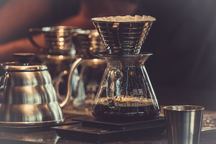 We have three different waters. One with 100% magnesium, one with 25% calcium/75% magnesium, and one with 50% calcium/50% magnesium. As you might have noticed, none of the waters have a high concentration of calcium. Calcium reacts with bicarbonate at high temperatures, becomes insoluble, and causes scale. This can cause serious problems for espresso machines and batch brewers. Hence why we're keeping calcium in control. To create the waters we dissolved magnesium chloride, calcium chloride, and sodium bicarbonate into distilled water. We held the overall amount of general hardness, TDS, and buffer the same across all waters. The exact ratios of each of the coffees are in a table below. The waters were initially made by Jon and relabeled by Christine so that none of us knew which water brewed which cup. The coffee was ground on a Baratza encore and brewed on a Kalita wave. Grind size, pouring pattern, and brew time were held constant across all coffees. Theoretically, the only thing that varied is the content of the waters. Confused is a 75% to 25% ratio MgCl2 is Magnesium CaCl2 is Calcium NaHCO3 is Sodium Bicarbonate i.e. Baking Soda that acted as our buffer. We thought of it all. Controlled for everything. The true scientist way. HOWEVER, in my haste to cook pasta carbonara and make the waters at the same time, I didn't have time to quality control test the water for general hardness and buffer. This might come into play later. Little has changed since Ochem lab, when I forced my lab partner and friend, Jose Luis Olmos Jr., to redo a two hour experiment with me because I "accidentally" dropped our final precipitate into a melted "ice" bath. Fortunately, if we have to redo this experiment of drinking a bunch of coffee, I don't think anyone will be too disappointed. The method consisted measuring out the three waters, Christine brewing one cup of coffee for each water, resulting in three total cups of coffee. We tasted each coffee at three different temperatures, and then wrote down our thoughts and graded each coffee for sweetness, body, flavor, and overall cup quality. Results Tldr After we finished the third cup of coffee at the coolest temperature, we compared notes and scores. We weren't speaking at all during the actual experiment to ensure our thoughts didn't effect the others' opinion. Our results seemed . . . well . . . here they are. More Magnesium seems to be in the lead (i.e. the 100% or 75% ratio) but we need more data. Christine and Bryce have consistent taste buds, and I most likely screwed up the experiment. Fancy graphs and stuffSo . . . which water made the best coffee? I summed all of the data and put it in the graph below. As you can see, the answer is "magnesium, maybe?" First impressions, you look at the graph, it looks like the 100% magnesium water has good sweetness, the best flavor, and the best taste overall. But there were three of us and straight magnesium BARELY pulled it out, so does that really tell us anything? Ehhh, probably not. We did find out a few other interesting things. 1) Christine has good taste buds. We noticed that the more magnesium in the water, the more Christine liked the coffee. This is what we call a dose-response relationship and it usually implies a relationship between two variables. Christine's taste buds provided much more clarity than our data, and they leave me hopeful in magnesium. 2) Bryce likes bitter coffee. Bryce also had a dose-response relationship. The more calcium in the water, the more Bryce liked the coffee. It also happened that the more calcium, the more bitterness. See 3 for why. 3) My carbonara was good, but my science was not. Listen to these tasting notes: Less sweet smelling from get go, a little thinner, almost silky but not quite, weak in both mouthfeel and flavor, sweetness subtle, acidity lacking, taste lame, all around boring. Those are Christine's tasting notes on the 50/50 coffee and the last three notes, "acidity lacking, taste lame, all around boring" - scream TOO MUCH BUFFER to me. Meaning we put too much baking soda in the water. I was playing around the next night, trying to make more water for more data. This time I actually did a quality control test on the water. The buffer was almost TWO TIMES as high as I wanted it to be. I think there was an issue with our concentrate during our experiment. Awkward turtle. All of our data, may have been meaningless. Just like Ochem. After discussing with Christine, we are going to continue the experiment over the next few weeks. We have the water dosed and will try each water again, for multiple days, and take thorough notes of our morning coffee. Hopefully, by the time the camper is ready, we will have enough data to find a more accurate correlation. Thanks everyone! We'll keep you up-to-date. Best,
|
| We wanted to see if we could tell a difference in the coffee if the water had a buffer. So we made our own water by adding a buffer. We added a tiny amount (0.02g) of baking soda (buffer) to 800 grams of our double filtered water. We tested the water with the KH solution and got to three drops, or 51ppm of alkalinity, which is in the ideal brewing range as per our graph. We then did a blind experiment comparing coffee brewed with our regular double filtered water and one brewed with our double filtered water with added buffer (baking soda). Jon knew which water was which. I did not. We brewed THIS seasonal Kenyan from Thou Mayest in the same kalita wave, using the same water-to-coffee ratio, and the same water temperature. |
After they brewed, we ensured both coffees were at the exact same temperature (140 degrees), and then drank the coffee and graded on flavor, mouthfeel, acidity, and aroma. We wrote down our thoughts separately without sharing.
We waited five minutes and re-tasted at a lower coffee temperature (the colder the coffee the more you can taste the good, bad, and ugly in coffee).
It was really that second tasting that made it clear as day to me.
There was no question. The blue cup had a much higher, more uncomfortable acidity, and pulled out more tomato flavors that made me pucker. It had a slightly sour-lemony after taste. The pink cup, had nice nutty flavors, low but good acidity, and almost no vegetal characteristics. It smelt like sweet cocoa and was full bodied on my tongue.
It was really that second tasting that made it clear as day to me.
There was no question. The blue cup had a much higher, more uncomfortable acidity, and pulled out more tomato flavors that made me pucker. It had a slightly sour-lemony after taste. The pink cup, had nice nutty flavors, low but good acidity, and almost no vegetal characteristics. It smelt like sweet cocoa and was full bodied on my tongue.
I pointed to the pink cup and said to Jon, “this one has the buffer.” Sure enough I was right. The pink cup of coffee, which was literally the exact same as the blue cup, other than the added buffer, was superior in flavor, mouthfeel, acidity, and aroma. Hands down in every category.
So here I am. Drinking a cup of coffee brewed with the baking soda water solution and loving my life. I used to think science was lame. But I write to you today to tell you it is not. It’s the Ryan Gosling of school subjects and professions. Science can get you to the moon, to your next destination, to your best cup of coffee, to your best date night. If you are wanting to recreate this experiment at home, all you need is that $7 test from amazon. You may not need the baking soda depending on your results from the test. You can use Henden's ideal brewing chart (below) to see where your home water sits in the graph and make decisions about filtering, adding buffer, etc from there. Feel free to contact us or comment below if you have any questions or try the experiment at home!
E n j o y t h e d i s c o v e r y .
Happy Brewing,
Christine Clutton
Owner/Operator/Barista
So here I am. Drinking a cup of coffee brewed with the baking soda water solution and loving my life. I used to think science was lame. But I write to you today to tell you it is not. It’s the Ryan Gosling of school subjects and professions. Science can get you to the moon, to your next destination, to your best cup of coffee, to your best date night. If you are wanting to recreate this experiment at home, all you need is that $7 test from amazon. You may not need the baking soda depending on your results from the test. You can use Henden's ideal brewing chart (below) to see where your home water sits in the graph and make decisions about filtering, adding buffer, etc from there. Feel free to contact us or comment below if you have any questions or try the experiment at home!
E n j o y t h e d i s c o v e r y .
Happy Brewing,
Christine Clutton
Owner/Operator/Barista
THE WILD WAY CONTRIBUTING WRITERS:
CHRISTINE CLUTTON
boss lady
JON CLUTTON
coffee scientist
Science meets creativity in our coffee blog written by The Wild Way owners

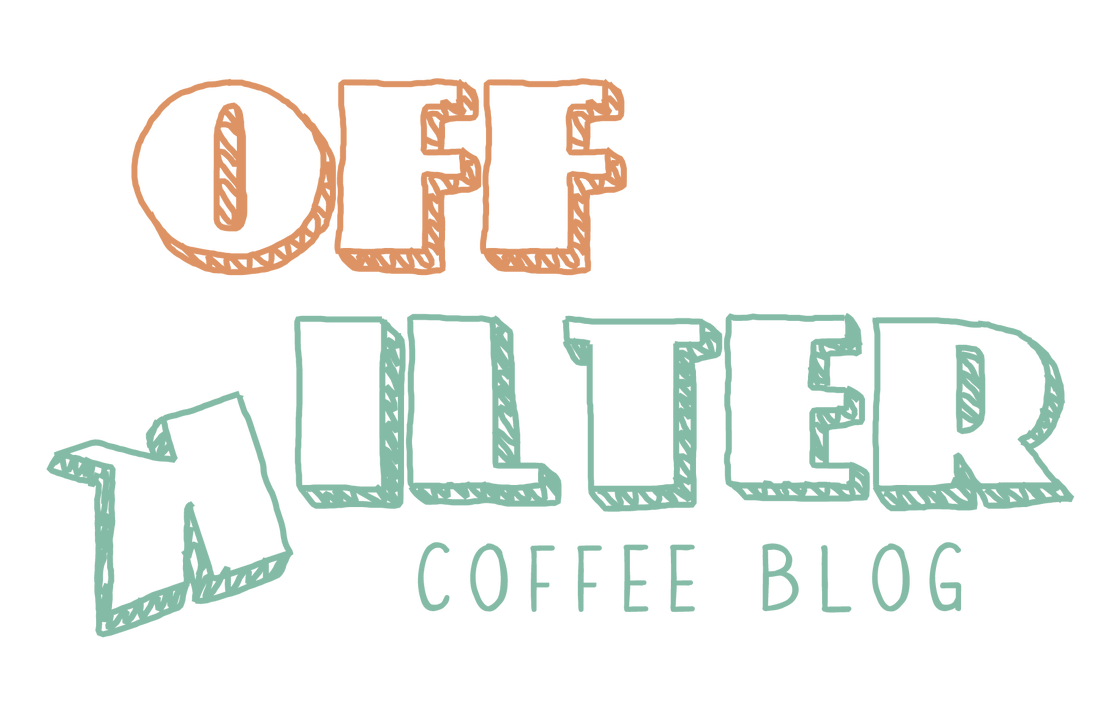
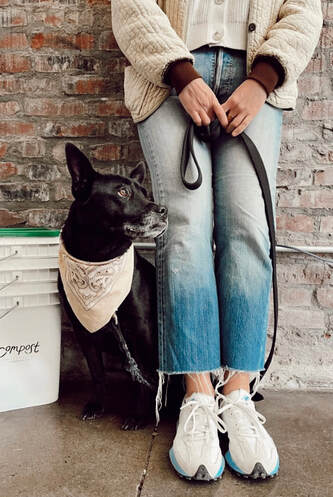



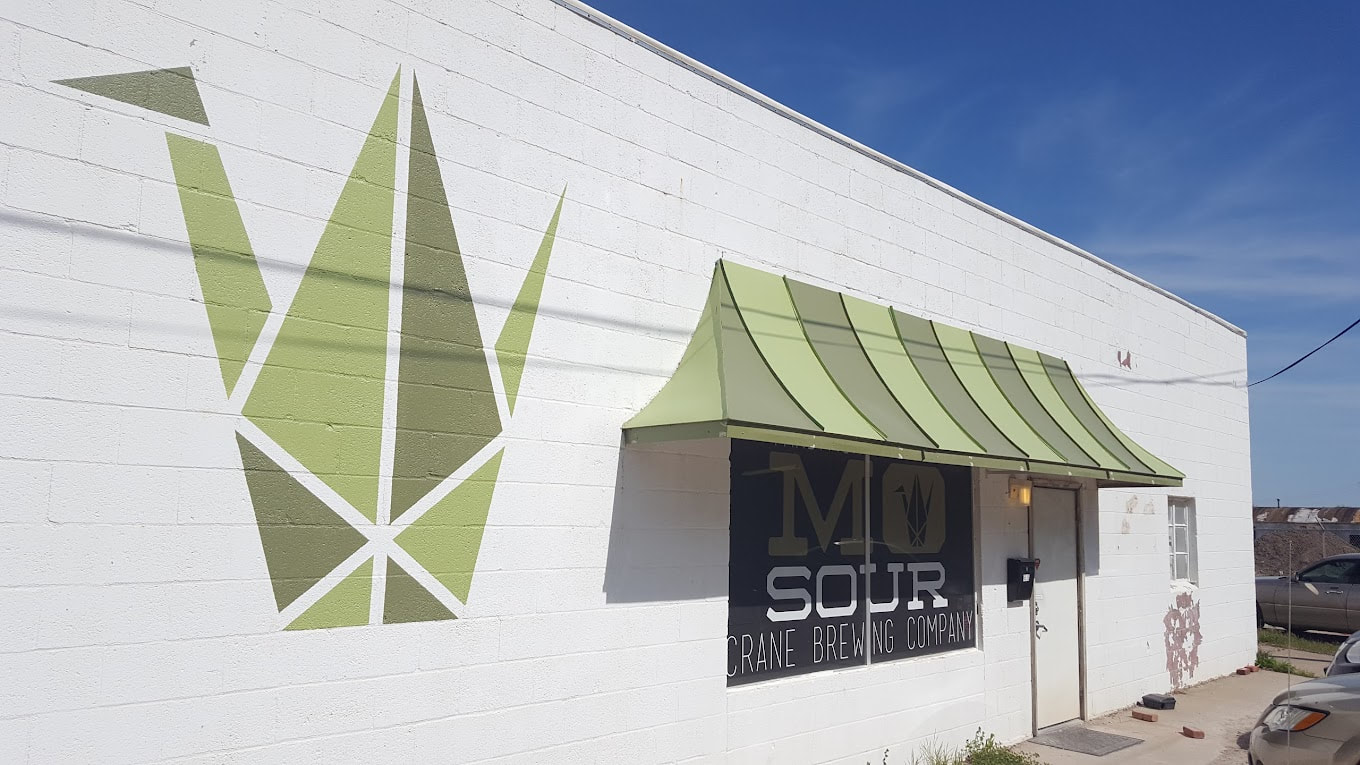

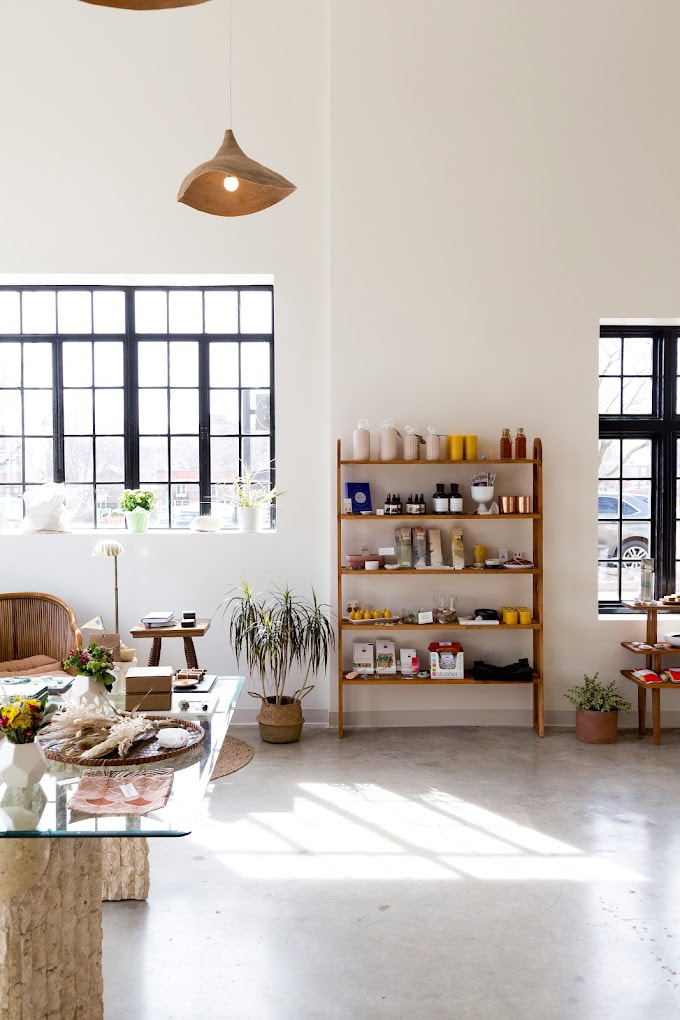

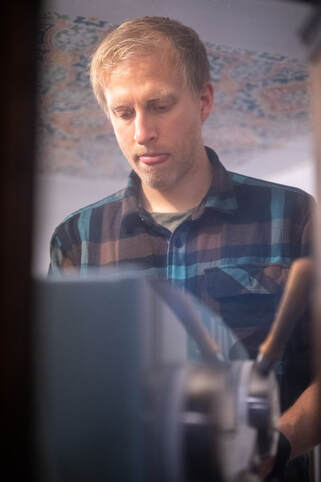
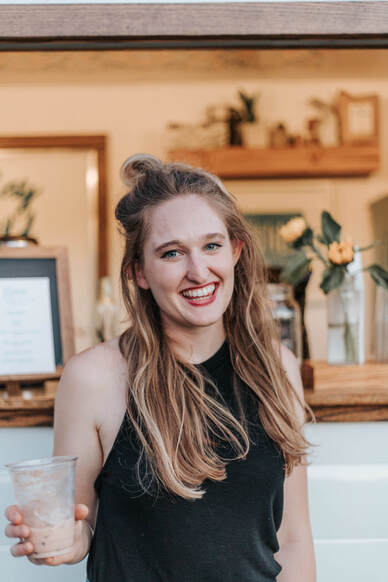

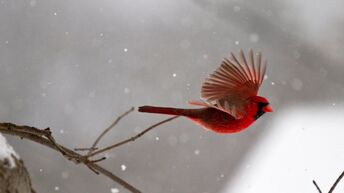

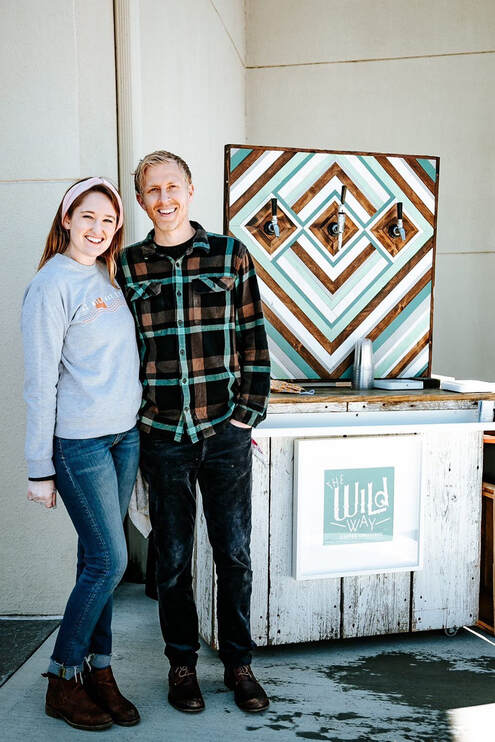


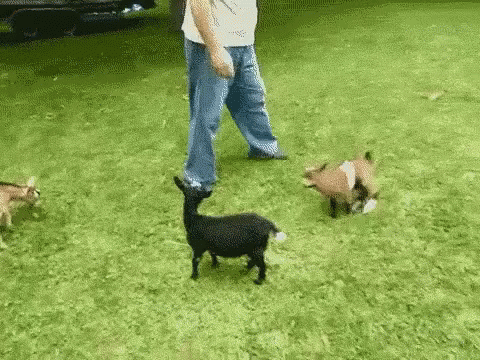
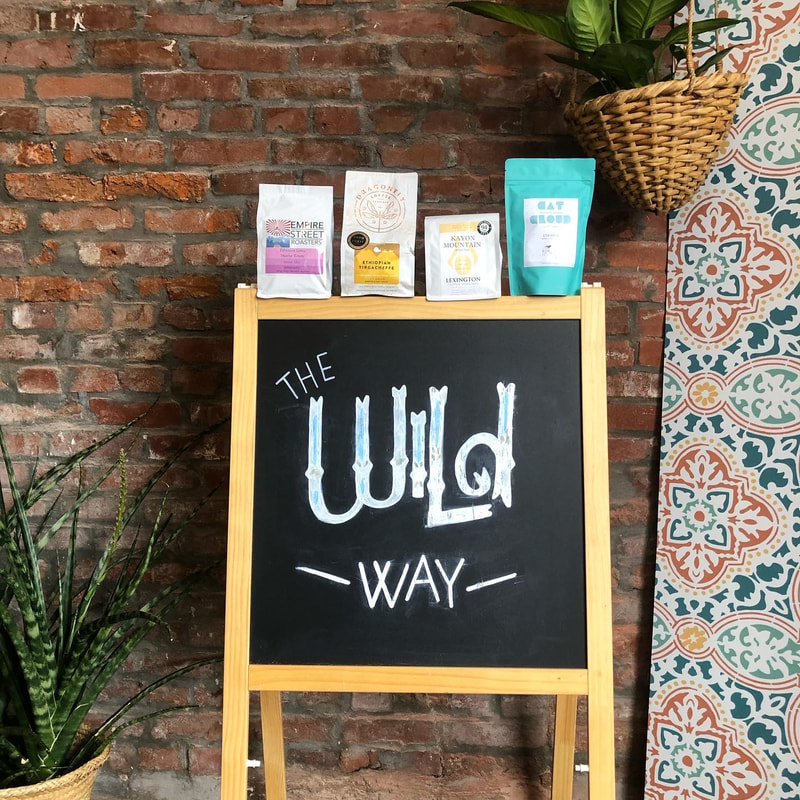
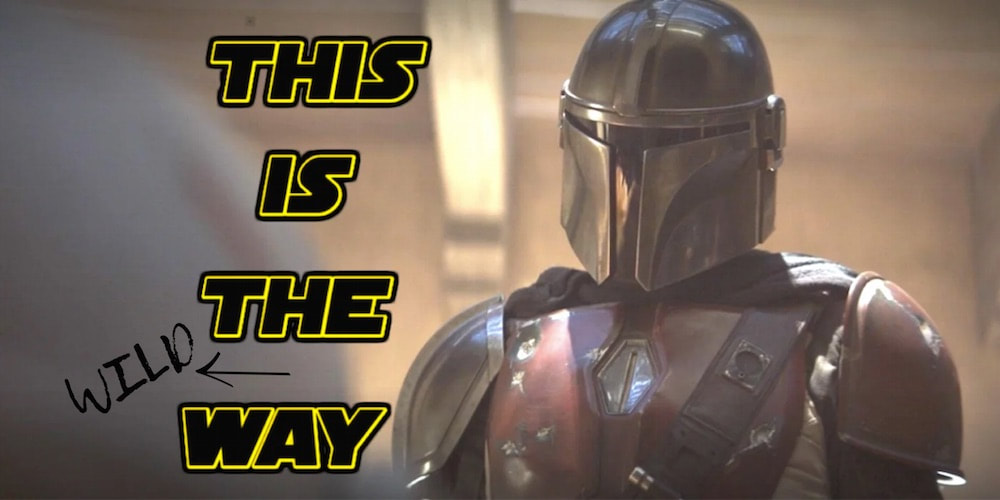

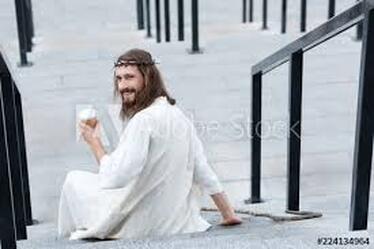
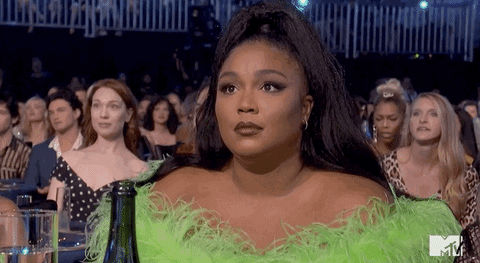
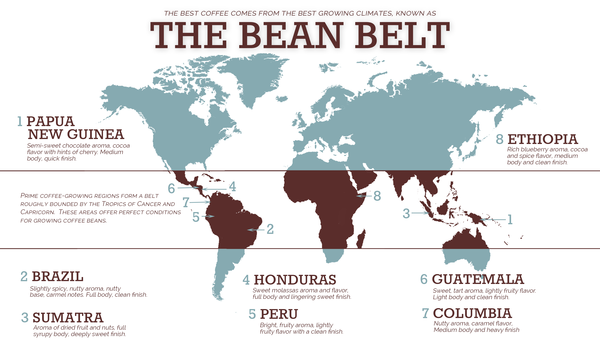
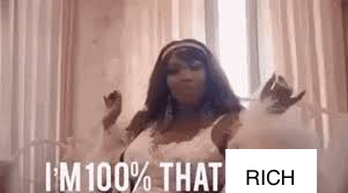
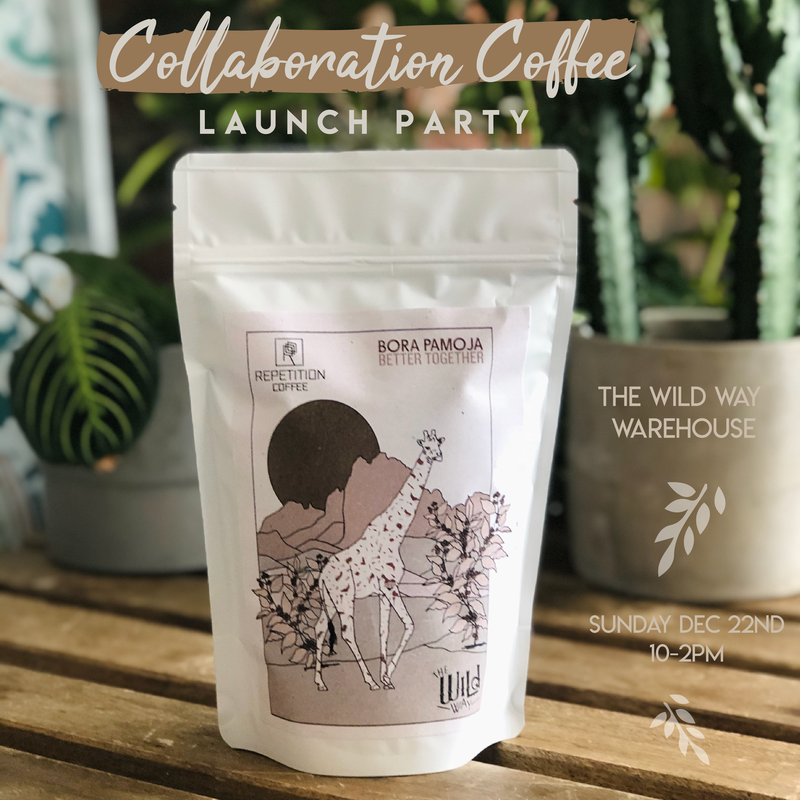


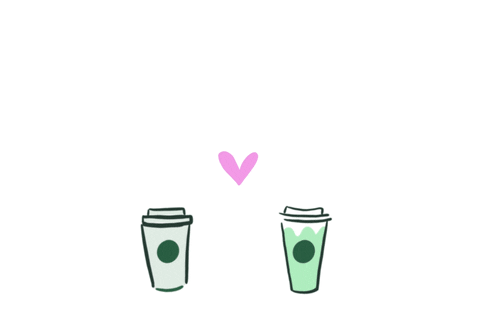

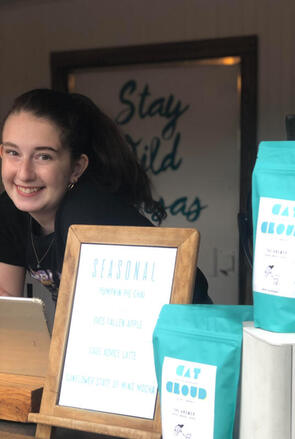





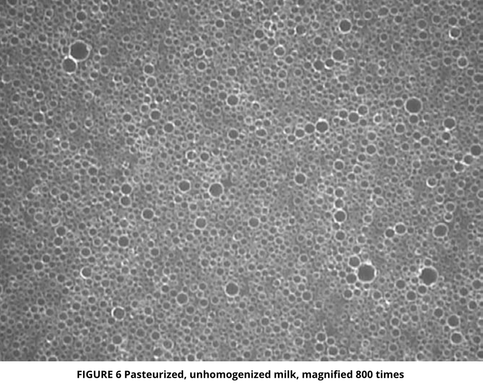
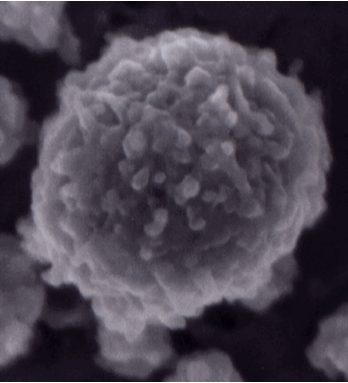

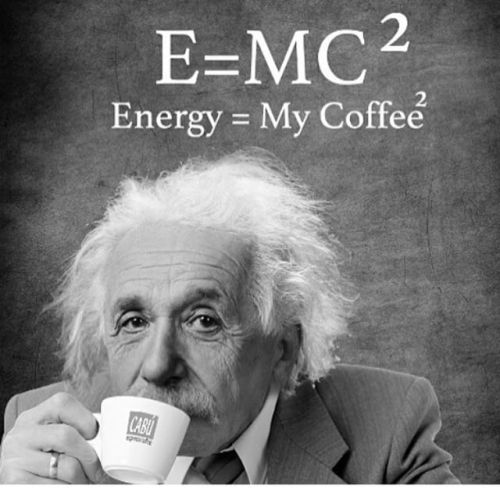

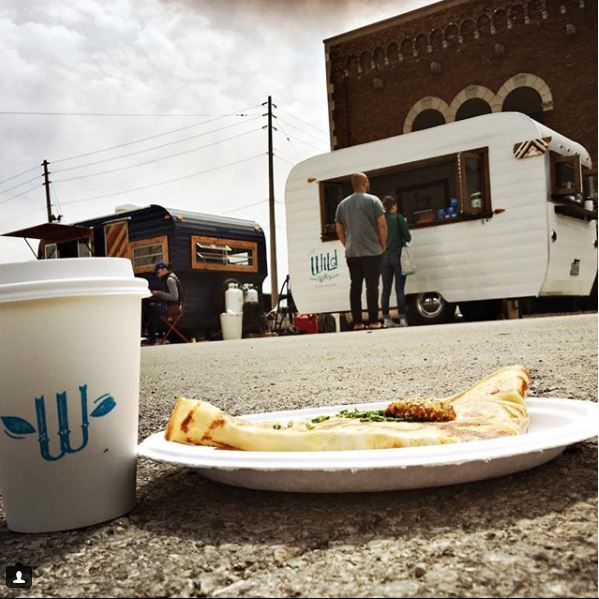





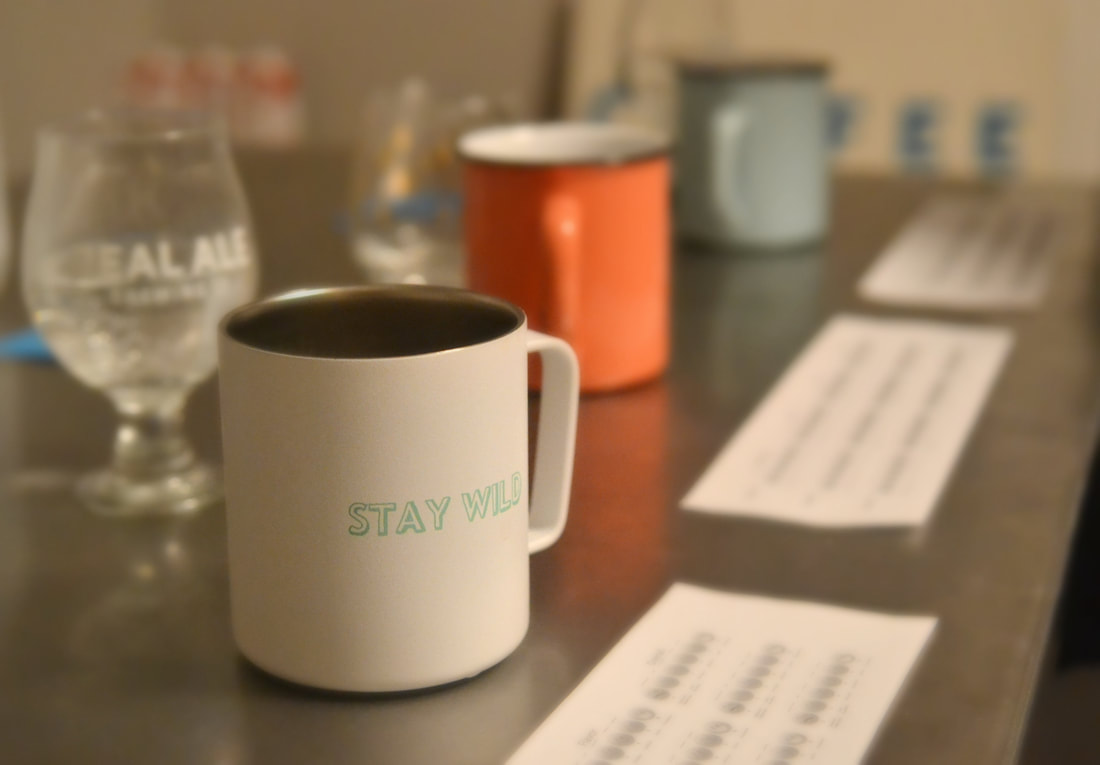




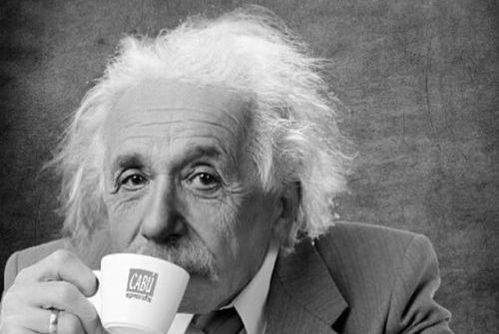




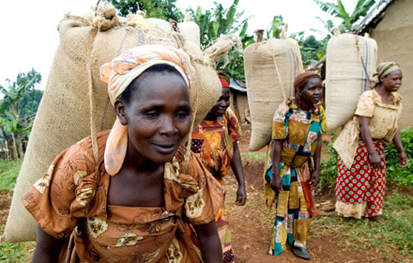

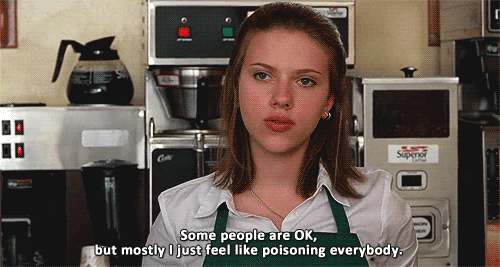

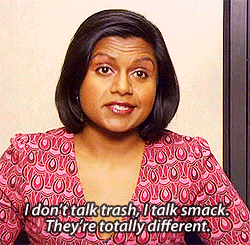

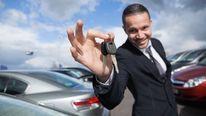

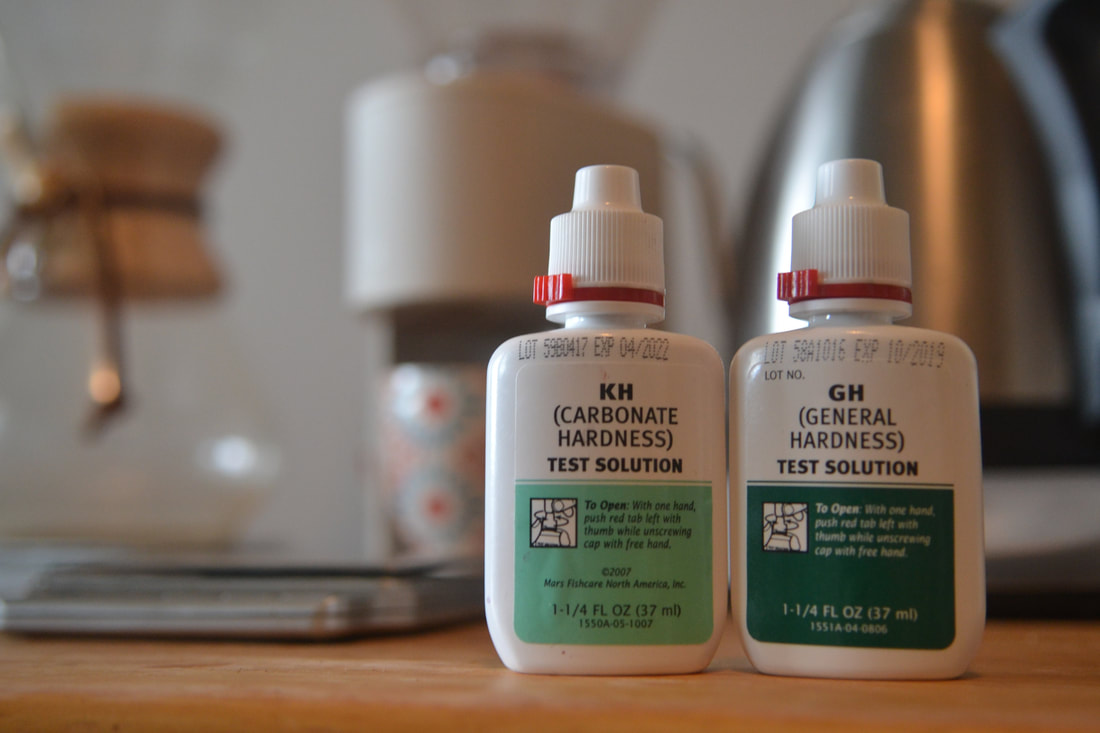



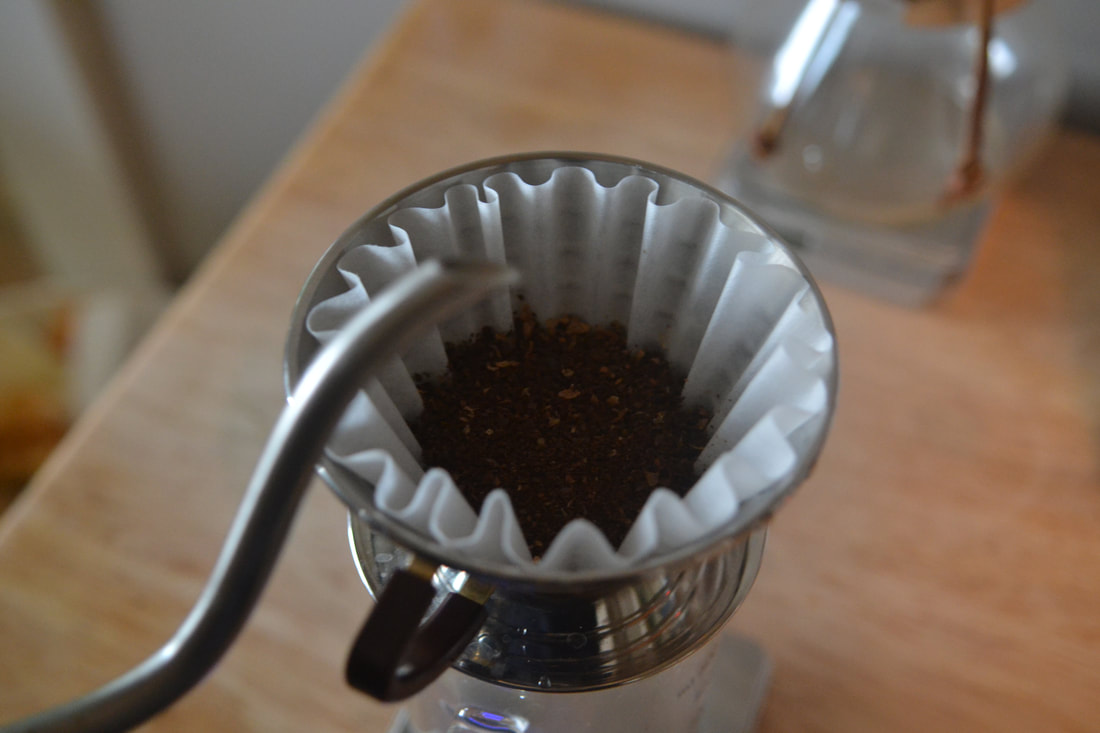




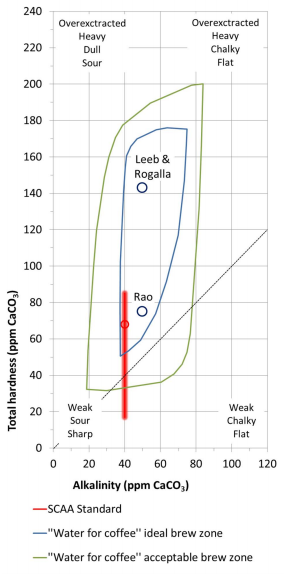
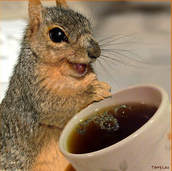
 RSS Feed
RSS Feed
